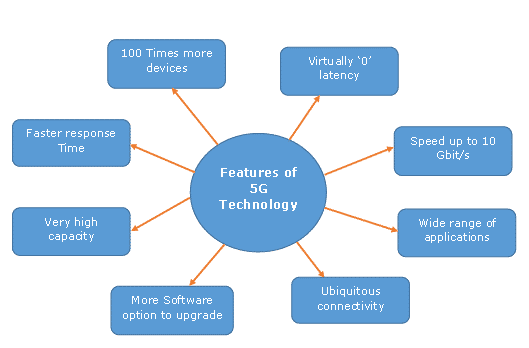5G – Know Everything About It!

Introduction To 5G
Radio technologies have given evidence of a fast and multi-dimensional development with the launch of analogue cellular systems in the 1980s. After this, digital wireless communications systems are on a continuous mission to meet the growing need of humans. With 5G, the data transmitted over the wireless broadband connection can be as high as 20 Gbps with a few estimates more than the speed of the wireline network, as well as providing less delay for 1 ms or less for real-time feedback. For the next (5th) generation wireless network horizon 201 9/2020, large-scale IOTs (the Internet of things) will address development beyond the mobile internet. The main development compared to today’s 4G and 4.5G (LTE Advanced) is that beyond improving the speed of data, new IOTs and significant communication use cases will require new types of better performance. For example, “low latency” provides real-time interactivity for services using the cloud: for example, it is important for the success of driving cars themselves. Apart from this, there is low power consumption which will allow the associated items to operate for months or years without the need for human assistance. Unlike current IOT services, which tend to shut down the display to get the best from current wireless technologies (3G, 4G, WiFi, Bluetooth, ZigBee, etc …), the 5G network is largely required for IOT The performance levels will be designed to bring. This will enable a completely ubiquitous connected world.

Features Of 5G
The upcoming revolution of the 5th generation mobile network or just 5G mobile technology is. Features and its utility are significantly higher than normal human expectations. With its very high speed, it has enough capacity to change the meaning of a cell phone applicability. With a large range of innovative features, now your smartphone will be parallel to the laptop. You can use broadband internet connection; Other important features that attract people include more gaming options, extensive multimedia options, connectivity everywhere, zero latency, fast response times, and high-quality sound and HD video without compromising the quality of audio and video on other cell phones. Can be transferred.
- Up to 10 Gbps data rate -> 10 to 100x improvements on 4G and 4.5G networks
- 1-millisecond delay
- 1000x bandwidth per unit area
- Up to 100x connected devices per unit area (compared to 4G LTE)
- 99.9 99% availability
- 100% coverage
- 90% reduction in network energy usage

Working Of 5G
Wireless networks are made up of cell sites which are divided into areas that send data via radio waves. Fourth Generation (4G) Long Term Development (LTE) provides the basis for wireless technology 5G. Unlike 4G, which requires large, high-powered cell towers to radiate signals over long distances, 5G wireless signal transmitted through small cell stations located in places like light poles or roofs of buildings Will go Use of many smaller cells is essential because the millimetre wave spectrum is a spectrum band between 30 GHz and 300 GHz, depending on whether the 5G produces high speed can travel only short distances and interference with buildings such as weather and physical barriers are subjected to . The previous generations of wireless technology have used the lower frequency band of the spectrum. To offset millimeter wave challenges related to distance and interference, the wireless industry is also considering the use of lower frequency spectrum for the 5G network, so network operators can use spectrum, which they already have on their new network Are to make The lower-frequency spectrum reaches more distance but less speed and efficiency than millimeter wave.

Health Issues
The World Health Organization (WHO) has researched their alleged effects on electromagnetic fields (EMF) and public health, it has concluded that such exposure within the recommended limits does not produce any known adverse health effects. In response to public concern, WHO established the International IMF Project in 1996 to assess scientific evidence of possible health effects of EMF from 0 to 300 GHz in the frequency range. He has said that although extensive research has been conducted in the possible health effects of the interaction of many parts of the frequency spectrum, but all the reviews made so far have indicated that, unless the ICNIRP (1998) emf limits the recommended limits Below are the exposure below, which covers the full frequency range from 0-300 GHz, such exposure is known to be a known adverse health risk. Do not produce expressions. Strong or more exposure to the emf can be unhealthy, and actually, work as the basis of an electromagnet weapon.



